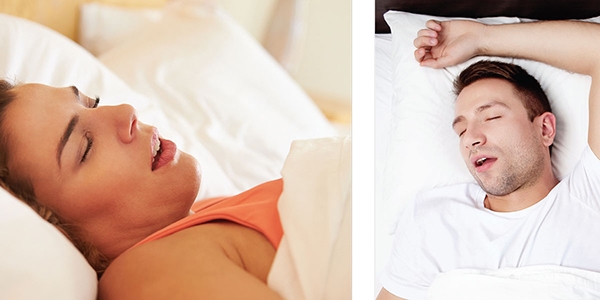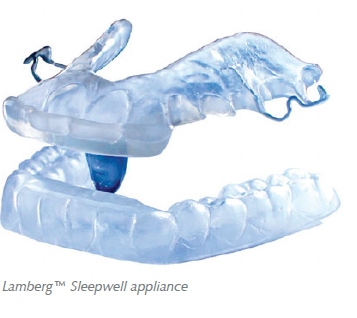Sleep Appliance Therapy: Where It Is And What It Needs To Be
 There are easily more than a hundred dental sleep appliances on the market today. All of them are different – some in ways more subtle than others – but different nonetheless. And that number is growing, bringing us better designs that include modifications on current appliances and totally new appliances, as well. Every patient is unique. One may have periodontal issues, another may be partially edentulous and yet another may be a severe bruxer. Each has their own “dental landscape.”
There are easily more than a hundred dental sleep appliances on the market today. All of them are different – some in ways more subtle than others – but different nonetheless. And that number is growing, bringing us better designs that include modifications on current appliances and totally new appliances, as well. Every patient is unique. One may have periodontal issues, another may be partially edentulous and yet another may be a severe bruxer. Each has their own “dental landscape.”
When you take into account the variety of appliances and the uniqueness of every patient, it becomes crystal clear that finding the ideal sleep appliance to treat your patient is not and has never been a matter of “one size fits all.”
So how do you know which sleep appliance is the right one for any given patient?
Almost all of us begin our venture into sleep therapy by using one appliance. Whatever the reason, whether your friend or colleague recommended it or you read about it in an article or you went to your first sleep class and that’s the appliance they taught…chances are you start with one.
Even if you’re lucky and your “one-appliance armamentarium” ends up being the perfect choice for most of your sleep patients, you’ll still need to learn how to meet the basic criteria for helping your lab provide you with a workable functioning appliance.
I feel that one of the main reasons that appliances don’t work at a higher success rate overall is that a combined therapeutic approach, while often needed, is seldom considered.
You’ll need to know how to take a proper construction bite and/or impression for the appliance in question. You’ll need to determine what your starting point is for securing the construction bite. Is it an end-to-end bite? Is it made at a point that captures a position that is 50%-70% of the maximum slide from centric relation to the most protrusive position?
After you have treated your first two or three patients, it likely becomes quite clear that no single appliance will be the perfect fit for every patient.
Each appliance has its own limitations and every patient is different. For example:
- One type of appliance may hold the upper and lower jaw firmly together. For someone who is a mouth breather, this can prove to be nothing short of torturous. Claustrophobia and feeling locked-in easily leads to failure.
- Or let’s say your appliance of choice is retained in the patient’s mouth by grabbing the undercuts that naturally occur in the dentition. If the patient doesn’t have enough back teeth to anchor the appliance, the appliance will not stay in the mouth. That can prove to be an expensive mistake.
- Some patients are lateral bruxers, so any appliance that prevents lateral movement may be less than ideal. In fact some sleep appliances will not survive the force of bruxing and will simply break.
To be successful in deciding upon the right sleep appliance, you need to know:
- Materials, qualities, design and functional specifics of the different appliances. Hard acrylic? Cad-Cam Appliance? Does it allow lateral movement? Is it easily adjustable for patient and/or doctor? How is it retained – ball clasps? Is it lined with thermoplastic material? Can you adjust it and reline it easily?
- What are the controlling parameters in relation to the patient? You will need to perform a full and complete dental sleep examination and a TMJ exam. What are the number of teeth in both arches? Any signs of periodontal disease or decay? Are there broken fillings or crowns that need to be replaced? Signs of lateral bruxism? Does the patient open and close comfortably? What is the range of lateral movement? What is the range of movement from centric relation to the most protrusive position? What is the size of their tongue, the size of their arches, the patency of their nasal airway? Look at the tonsils, adenoids, the soft palate, hard palate. Do they have a high vaulted palate? Are they a skeletal class l, ll, or lll? As a dentist we should be looking at all possible levels of obstruction: nasal, oral and hypopharyngeal airway space. Knowing the answers to these questions is of primary importance.
- Is a combined therapeutic approach warranted? I feel that one of the main reasons that appliances don’t work at a higher success rate overall is a combined therapeutic approach, while often needed, is seldom considered.
Even when you choose what you believe to be the best appliance for the patient, even when you have a firm grasp of the patient landscape, even when you cover all the basics and evaluate all the single appliance possibilities, it may not be enough. You still may need to implement a combined therapy approach.
This approach may prove as simple as prescribing a sleep appliance with a nasal strip – to encourage the patient to breathe nasally and keep the air passage open. It may be as detailed and in-depth as employing CPAP with an appliance of choice.
What if your patient’s nose is completely blocked? Perhaps they have a significantly deviated septum or polyps obstructing the nasal airway. For a patient like that, therapy may include airway surgery before adding an appliance.
Because every patient is different, here are some sample combination approaches for your consideration:
The Aligner Sleep Appliance™ (ASA) and the DNA Appliance
 I think it’s fair to say that there is a direct correlation between malocclusion and sleep apnea. Research will back me up on this. Those of you who are treating malocclusion patients – Invisalign or adult patients – with an appliance approach, need to evaluate those patients for sleep apnea. They may be your orthodontic patients, but you should also view them as potential sleep patients.
I think it’s fair to say that there is a direct correlation between malocclusion and sleep apnea. Research will back me up on this. Those of you who are treating malocclusion patients – Invisalign or adult patients – with an appliance approach, need to evaluate those patients for sleep apnea. They may be your orthodontic patients, but you should also view them as potential sleep patients.
Luckily for those undergoing Invisalign therapy, we have an appliance – the ASA — that can be utilized during Invisalign treatment and will allow you to treat that patient’s apnea concomitantly. Not only will you be improving the size of their arches and their intraoral volume, you also will be helping them sleep better during the treatment.
For those of you doing orthodontic appliance therapy with adult patients, a DNA appliance (and its partner, the mRNA device) are both known to be successful at treating their apnea as well.
The Lamberg™ Sleepwell
 If you’re treating a patient for bruxism, TMJ or any condition somewhere within the spectrum of joint dysfunction – pop/click, pain, etc., it’s in your best interest to exercise caution when prescribing a splint/orthotic without testing them for a sleep disorder. Numerous articles and investigations confirm a definite link between bruxism and sleep apnea. And although the research is ongoing, it’s pretty clear that a high percentage of the bruxing population will also suffer from sleep apnea.
If you’re treating a patient for bruxism, TMJ or any condition somewhere within the spectrum of joint dysfunction – pop/click, pain, etc., it’s in your best interest to exercise caution when prescribing a splint/orthotic without testing them for a sleep disorder. Numerous articles and investigations confirm a definite link between bruxism and sleep apnea. And although the research is ongoing, it’s pretty clear that a high percentage of the bruxing population will also suffer from sleep apnea.
Designed to stop bruxism and reposition the mandible, the Lamberg™ SleepWell may be the ideal solution for a bruxer.
The Full Breath™ Solution and Zyppah™
 Many doctors will swear that it is better to control the tongue without venturing into Mandibular Advancement Devices. MADs change the occlusion. They just do.
Many doctors will swear that it is better to control the tongue without venturing into Mandibular Advancement Devices. MADs change the occlusion. They just do.
For patients with a large tongue, mandibular advancement may not be successful enough. Sometimes tongue retention is preferable for correcting what is wrong, especially if a patient experiences pain with a MAD. The Full Breath Solution™ and Zyppah™ Appliances provide the greatest promise for such approaches.
In many cases, the expectation that you might get everything done with a single appliance approach – or that one size fits all and all you have to do is put the thing in your patient’s mouth – is foundational to why we experience a 50% success rate as opposed to a 90% success rate. You can improve your success rate if you take a close look at both appliance potentiality and pre-existing patient conditions – the full patient landscape, variables and all – and select an approach that will work best for the patient.
The goal, simply stated, is to open the airway and keep it open. Whatever it takes. Taking into consideration appliance characteristics and patient parameters, try and get as close as possible to the appliance – or combination approach — that you think is going to work.
The future of sleep is active prevention and active treatment of the entire spectrum of sleep disorders.
What does the future hold? In addition to that steady stream of new designs spoken of earlier – and ongoing research and development into the utilization of low level oxygen delivery/mechanisms for treating OSA – there’s another emerging trend/concept/awareness that has my immediate attention: the application of microchips in what I term “accountability therapy.”
We must be able to make sure that our appliances are actually being used. Taking a sleep test to show that the appliance works when it’s worn just isn’t enough. We’re going to have to show that the patient is actually wearing the appliance – similar to what is already being done in CPAP therapy. That level of accountability promises to be a definite game changer in the field of sleep.
Early recognition and prevention are the real game changers. Most sleep appliances today are essentially band-aids. They manage the problem of OSA but they don’t prevent it. The future of sleep is active prevention and active treatment of the entire spectrum of sleep disorders.
The possibilities, as they say, are endless. Confidence in the here and now of sleep appliance therapy is a function of first embracing the fact that selecting the right appliance for your patients is never a case of “one size fits all.” Even when you’ve chosen what you believe to be the perfect appliance, it may still fail for a host of other reasons, e.g. inaccurate records, incomplete information, reluctance to consider combination therapy.
Match the materials and technological componentry to the existing dental landscape of each individual patient….and then explore the third variable – the possibility that combined therapy may just be the “fitting” solution.
For more on the range of available sleep appliances for all types of sleep appliance therapy, be sure to access and review our extensive sleep section at SMLglobal.com. Or call us at 800-423-3270 to schedule a 30-minute Powerpoint presentation or custom webinar/workshop detailing how our sleep experts and appliances can help you integrate sleep therapy into your growing practice.